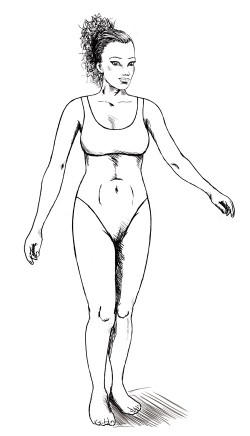| CONSTITUTION | Long limbs, small bones, oval-shaped or elongated face and high waist |
| FAT LOCALIZATION | Throughout the body, usually apart from the calf muscles |
| DIETARY PREFERENCES | Carbohydrates and caffeine |
| ENERGY LEVEL | Warm, alternates energy peaks with a tendency to lack energy |
| PERSONALITY | Enthusiastic and full of initiative in the positive periods, tends to be irritable and depressed when tired or stressed |
| PREDOMINANT GLAND | Thyroid |
| PHYSICAL CHARACTERISTIC | athletic, with good flexibility and coordination |
| GENDER | Equally found in men and women |

The overweight hypermixed individual accumulates fat in an equal way over the whole body, but always maintains a visible waistline and thin calf muscles.

The hypermixed individual on his/her target weight has an athletic and well-structured configuration with long and lean limbs.
The hypermixed biotype, or classical mixed biotype, is an individual that morphologically accumulates fat both in the upper and the lower part of the body. This biotype corresponds with the bilious type described by Hippocrates. Long-limbed, active, suffering from hyperthyroidism and hyperpituitarism, these individuals do not easily gain weight but, because of their positive metabolism, they eat too many carbohydrates that stimulate the prevailing gland, the thyroid, until it becomes exhausted and results in consequent fat accumulation, in this case throughout the whole body. However, the “pepper-shaped” morphology can also be found in other biotypes (hypolipolytic and hyperlipogenetic). In old age, particularly when the menopause occurs in women and andropause in men along with the relevant hormonal changes, they also tend to acquire the characteristics of the opposite biotype. We can call this biotype the “transitional mixed biotype”.
Instead, the traditional mixed biotype is an individual with a good hormonal balance who tends to take advantage of this situation, eating mostly sugary foods and carbohydrates, as this is supported by a good thyroid metabolism. In the past he might have gained weight eating considerable amounts of food that overstimulated the thyroid: sugary foods, soft drinks (sugary sparkling drinks), bread, pasta, pizza and potatoes. But, eventually, everyone has to “foot the bill”, and this excessive thyroid stimulation, if it lasts for too long, leads to exhaustion of the gland itself. This imbalance leads to an accumulation of fat and/or cellulite on hips, thighs and abdomen.
DIET
The dietary strategy of a hypermixed person ultimately, consists of: eggs every day, a large quantity of proteins from chicken and fish, and a moderate amount of red meat; limited amounts of carbohydrates in the form of whole grains, a high quantity of vegetables, especially the fibrous ones to assure vitamin and mineral intake and to give the sensation of a full stomach whilst compensating for the limited fruit, which is too sugar-rich.
Percentage of macronutrients in the diet
Carbohydrates/proteins/fats
33/33/33
